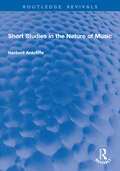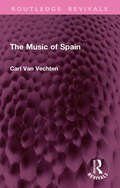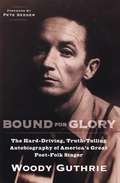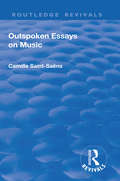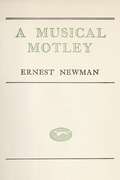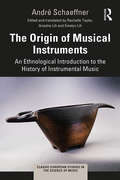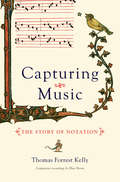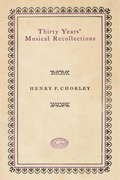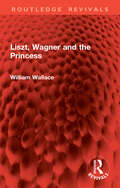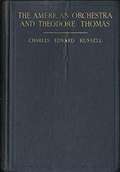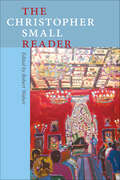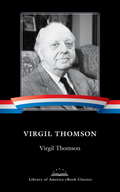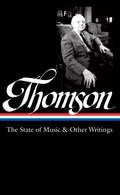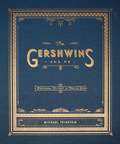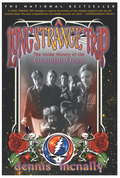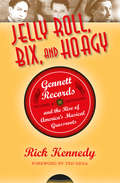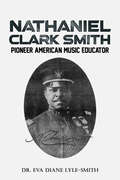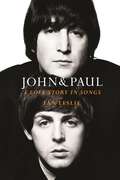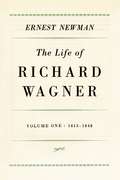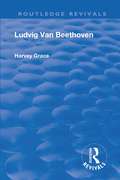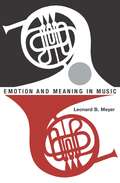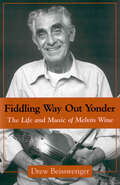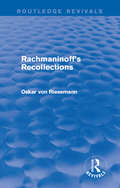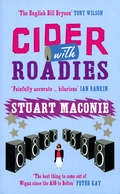- Table View
- List View
Short Studies in the Nature of Music (Routledge Revivals)
by Herbert AntcliffeShort Studies in the Nature of Music (1920) examines the origin and nature of music, prompting lines of thought for greater analysis. It touches on human nature, the arts and their importance to human life, and the sciences of psychology and sociology.
The Music of Spain (Routledge Revivals)
by Carl Van VechtenFirst published in 1920, The Music of Spain deals with historical periods, schools and style and appears to embrace everything related to music provided it affects or is affected by Spain in some degree, no matter how small or insignificant. The period extends from the sixteenth century to the early twentieth century and the author encircles his subject in a huge ring or parenthesis that opens with Antonio Cabezon, the Spanish Bach (according to Pedrell) and closes with the gypsy dancer and singer Pastora Imperio, queen of the Spanish “varieties” stage of today. It brings themes like Spain and music; the land of joy; and from George Borrow to Mary Garden. This book is an important historical reference for students and scholars of history of music, Spanish music.
Bound for Glory
by Woody GuthrieBound for Glory is the autobiography of Woody Guthrie, the founder of modern American folk music. It is a funny, cynical, earthy and tragic account of his life in an Oklahoma oil-boom town, of the Depression that followed,and of his subsequent travels in, on,and under trains, in stolen cars and on his feet, round an America going rotten from the top downwards
Revival: Outspoken Essays on Music (Routledge Revivals)
by Camille Saint-SaensA series of essays on reactions and emotional responses to music.
The History of Pianoforte Music (Routledge Revivals)
by Herbert WesterbyOriginally published in 1924, and authored by a renowned pianist and musicologist, this book is a comprehensive study of the history and evolution of pianoforte music from its origins in the early 18th century to modern times. The book begins with a discussion of sixteenth-century English composers for the virginal. Special emphasis is given to works of the Romantic period and to national styles of piano music such as those of Chopin and the Polish school, Liszt and Magyar music, and Cesar Franck and music of The Netherlands. The book provides a bibliography and lists of major collective editions, publishers of piano music throughout the world, and journals for pianists.
A Musical Motley
by Ernest NewmanThis is a reproduction of a book published before 1923. This book may have occasional imperfections such as missing or blurred pages, poor pictures, errant marks, etc. that were either part of the original artifact, or were introduced by the scanning process. We believe this work is culturally important, and despite the imperfections, have elected to bring it back into print as part of our continuing commitment to the preservation of printed works worldwide. We appreciate your understanding of the imperfections in the preservation process, and hope you enjoy this valuable book.
The Origin of Musical Instruments: An Ethnological Introduction to the History of Instrumental Music (Classic European Studies in the Science of Music)
by André SchaeffnerThe work of French musicologist, ethnologist and critic Andre Schaeffner (1895– 1980) grew out of his first organological studies of the history of Western classical instruments in the late 1920s and encapsulated in his wide-ranging Origine des instruments de musique, which captures his studies in Paris between 1931 and 1936. Almost 80 years after its first publication, the scientific relevance and influence of Schaeffner’s primary hypothesis—that the origins of music can be traced to the human body through gesture, dance and the movements in the use of musical instruments and their ancestor tools—remains pertinent in fields which have returned to informed speculative and empirical research on the origins of music. This first English edition is accompanied by editorial footnotes and introductory texts, and the influence of Schaeffner’s thought on several generations of musicologists makes his work an essential piece of reading for ethnomusicologists, music psychologists, organologists and musicologists interested in the history of their field.
Capturing Music: The Story Of Notation
by Thomas Forrest KellyAn entertaining history of how musicians learned to record music for all time, filled with art that sings. In today’s digital landscape, we have the luxury of experiencing music anytime, anywhere. But before this instant accessibility and dizzying array of formats—before CDs, the eight-track tape, the radio, and the turntable—there was only one recording technology: music notation. It allowed singers and soloists to travel across great distances and perform their work with stunning fidelity, a feat that we now very much take for granted. Thomas Forrest Kelly transports us to the lively and complex world of monks and monasteries, of a dove singing holy chants into the ear of a saint, and of bustling activity in the Cathedral of Notre Dame—an era when the only way to share even the simplest song was to learn it by rote, church to church and person to person. With clarity and a sense of wonder, Kelly tells a story that spans five hundred years, leading us on a journey through medieval Europe and showing how we learned to keep track of rhythm, melody, and precise pitch with a degree of accuracy previously unimagined. Kelly reveals the technological advances that led us to the system of notation we use today, placing each step of its evolution in its cultural and intellectual context. Companion recordings by the renowned Blue Heron ensemble are paired with vibrant illuminated manuscripts, bringing the art to life and allowing readers to experience something of the marvel that medieval writers must have felt when they figured out how to capture music for all time.
Liszt, Wagner and the Princess (Routledge Revivals)
by William WallaceOriginally published in 1927, this illuminating study concerns three people, about two of whom much has already been written. The third, Princess Carolyne Sayn-Wittgenstein, has attracted less attention, in spite of her having occupied the greater part of Liszt’s inner life. The Princess in the large sense was an unmusical woman. It is a question whether her influence over Liszt was of a beneficient nature. She interested herself in Berlioz only for the purpose of checkmating Wagner, whom she hated, and thus set Liszt against Wagner whenever possible. The complex relationships of this inscrutable and not altogether scrupulous trio are here considered for the first time in a way which adds much of value to our estimate of the characters of Wagner and Liszt.
The American Orchestra and Theodore Thomas
by Charles Edward RussellThe history of the American orchestra.<P><P> Pulitzer Prize Winner
The Christopher Small Reader (Music/culture Ser.)
by Christopher SmallThe Christopher Small Reader is the fourth and final book in Christopher Small's legacy as a composer, pianist, teacher, friend, provocateur, and influential outsider in classical music studies. It is at once a compendium of, a complement to, and an important addition to Small's prior books: Musicking; Music, Society, Education; and Music of the Common Tongue. The Christopher Small Reader brings previously published work, some of it available in disparate locations, together with key excerpts from his three books, and other writings that remained unpublished at his passing in 2011, making available ideas that were not included in the earlier books and presenting an overview of his thought over the course of his life. The collection is a fitting capstone, providing rich insights into Small's understanding of musicking as a crucial way of relating to the world.Hardcover is un-jacketed.
Virgil Thomson: A Library of America E-Book Classic
by Virgil ThomsonVirgil Thomson was a gifted composer and one of the nation's foremost cultural critics. The best-selling autobiography Virgil Thomson (1966) is his gossipy telling of his own extraordinary progress from unteachable smart aleck to revered elder statesman. It recounts his artistically precocious Kansas City boyhood, demanding Harvard education, apprenticeship in Paris between the wars, and hard-won musical and literary maturity in New York. As narrator and protagonist, Thomson fascinates not only with his own story but also with those of his associates, collaborators, friends, and rivals, among them Gertrude Stein, Alice B. Toklas, Ezra Pound, James Joyce, Nadia Boulanger, George Antheil, Pablo Picasso, Jean Cocteau, Max Jacob, Pare Lorentz, John Houseman, and Orson Welles. Virgil Thomson is an authentic work of Americana and a first-rate, first-person history of the rise of modernism.Complete with 32 pages of photographs.
Virgil Thomson: Library of America #277
by Tim Page Virgil ThomsonAn unprecedented collection of polemical and autobiographical writings by America's greatest composer-critic. Following on the critically acclaimed 2014 edition of Virgil Thomson's collected newspaper music criticism, The Library of America and Pulitzer Prize-winning music critic Tim Page now present Thomson's other literary and critical works, a body of writing that constitutes America's musical declaration of independence from the European past. This volume opens with The State of Music (1939), the book that made Thomson's name as a critic and won him his 14-year stint at the New York Herald Tribune. This no-holds-barred polemic, here presented in its revised edition of 1962, discusses the commissions, jobs, and other opportunities available to the American composer, a worker in a world of performance and broadcast institutions that, today as much as in Thomson's time, are dominated by tin-eared, non-musical patrons of the arts who are shocked by the new and suspicious of native talent. Thomson's autobiography, Virgil Thomson (1966), is more than just the story of the struggle of one such American composer, it is an intellectual, aesthetic, and personal chronicle of the twentieth century, from World War I-era Kansas City to Harvard in the age of straw boaters, from Paris in the Twenties and Thirties to Manhattan in the Forties and after. A classic American memoir, it is marked by a buoyant wit, a true gift for verbal portrait-making, and a cast of characters including Aaron Copland, Gertrude Stein, James Joyce, Paul Bowles, John Houseman, and Orson Welles. American Music Since 1910 (1971) is a series of incisive essays on the lives and works of Ives, Ruggles, Varèse, Copland, Cage, and others who helped define a national musical idiom. Music with Words (1989), Thomson's final book, is a distillation of a subject he knew better than perhaps any other American composer: how to set English--especially American English--to music, in opera and art song. The volume is rounded out by a judicious selection of Thomson's magazine journalism from 1957 to 1984--thirty-seven pieces, most of them previously uncollected, including many long-form review-essays written for The New York Review of Books.From the Hardcover edition.
The Gershwins and Me: A Personal History in Twelve Songs
by Michael FeinsteinFrom celebrated entertainer Michael Feinstein comes a beautifully illustrated account of the lives and legacies of the Gershwins--told through stories of twelve of their greatest songs.The "Ambassador of the Great American Songbook" Michael Feinstein was just twenty years old when he got the chance of a lifetime: a job with his hero, Ira Gershwin. During their six-year partnership, the two became close friends. Feinstein blossomed under Gershwin's mentorship and Gershwin was reinvigorated by the younger man's zeal for his and his brother George's legacy. Now, in The Gershwins and Me, the only book of its kind, Michael Feinstein shares unforgettable stories and reminiscences from the music that defined American popular song, along with rare Gershwin memorabilia he's collected through the years. From "Strike Up the Band" to "Love Is Here to Stay," each of the twelve chapters highlights one of the Gershwins' classic songs, exploring the brothers' lives, illuminating what the music meant to them, and telling the stories of how their iconic tunes came to life. Throughout the star-studded narrative, Feinstein unfolds the moving chronicle of his own life with the Gershwins, describing his vision for their enduring presence today. No other writer could give us such an authoritative inside perspective on these titans of American culture. A timeless classic and the definitive account of the Gershwins and their legacy, The Gershwins and Me will having you humming with every turn of the page.
A Long Strange Trip: The Inside History of the Grateful Dead
by Dennis McnallyThe complete history of one of the most long-lived and legendary bands in rock history, written by its official historian and publicist--a must-have chronicle for all Dead Heads, and for students of rock and the 1960s' counterculture. From 1965 to 1995, the Grateful Dead flourished as one of the most beloved, unusual, and accomplished musical entities to ever grace American culture. The creative synchronicity among Jerry Garcia, Bob Weir, Phil Lesh, Bill Kreutzmann, Mickey Hart, and Ron "Pigpen" McKernan exploded out of the artistic ferment of the early sixties' roots and folk scene, providing the soundtrack for the Dionysian revels of the counterculture. To those in the know, the Dead was an ongoing tour de force: a band whose constant commitment to exploring new realms lay at the center of a thirty-year journey through an ever-shifting array of musical, cultural, and mental landscapes. Dennis McNally, the band's historian and publicist for more than twenty years, takes readers back through the Dead's history in A Long Strange Trip. In a kaleidoscopic narrative, McNally not only chronicles their experiences in a fascinatingly detailed fashion, but veers off into side trips on the band's intricate stage setup, the magic of the Grateful Dead concert experience, or metaphysical musings excerpted from a conversation among band members. He brings to vivid life the Dead's early days in late-sixties San Francisco--an era of astounding creativity and change that reverberates to this day. Here we see the group at its most raw and powerful, playing as the house band at Ken Kesey's acid tests, mingling with such legendary psychonauts as Neal Cassady and Owsley "Bear" Stanley, and performing the alchemical experiments, both live and in the studio, that produced some of their most searing and evocative music. But McNally carries the Dead's saga through the seventies and into the more recent years of constant touring and incessant musical exploration, which have cemented a unique bond between performers and audience, and created the business enterprise that is much more a family than a corporation. Written with the same zeal and spirit that the Grateful Dead brought to its music for more than thirty years, the book takes readers on a personal tour through the band's inner circle, highlighting its frenetic and very human faces. A Long Strange Trip is not only a wide-ranging cultural history, it is a definitive musical biography.
Jelly Roll, Bix, and Hoagy: Gennett Records and the Rise of America's Musical Grassroots
by Rick Kennedy&“A lively and anecdotal history&” of the tiny family-run studio where jazz greats from Jelly Roll Morton to Louis Armstrong made their first recordings (Jazz Times). From 1917 to 1932, in a primitive studio next to the railroad tracks, the Gennett family of Richmond, Indiana, recorded some of the earliest performances of jazz, blues, and country greats—including Jelly Roll Morton, Big Bill Broonzy, King Oliver, Louis Armstrong, Gene Autry, Bix Beiderbecke, and native Hoosier Hoagy Carmichael (whose &“Stardust&” debuted on Gennett as a dance stomp). Jelly Roll, Bix, and Hoagy is the first thoroughly researched account of the people and events behind this unique company and its outsized impact on American music. Alive with personal details and anecdotes from musicians, employees, and family members, it traces the colorful history of a pioneer recording company.
Nathaniel Clark Smith: Pioneer American Music Educator
by Dr Eva Diane Lyle-SmithIf you are interested in learning about a pioneer African American music educator in the United States, then you want to read the story of Nathaniel Clark Smith. Smith was a prolific and charismatic music educator, musician, and composer who lived during the early years of music education history in the United States. His formal training in music was on a military base in Ft. Leavenworth, KS. Extended studies were from Guild Hall in London, England. A college graduate with B.M.A. and M.M degrees, Smith taught music in educational institutions and industries; was a world traveller who performed with the Ernest Hogan Minstrel Troupe; introduced the saxophone to African Americans; composed and published spirituals, marches, operatic songs, a suite, and an unfinished symphony; and hosted a radio broadcast show which was aired all over the Mid-West. He organized bands and out of that, orchestras, choirs, glee clubs and numerous combinations of the voice and instruments were developed. Smith captured the melodies of the countries that he visited in his music compositions.During his illustrious career, Smith worked with Frederick Douglas, Paul Lawrence Dunbar, Booker T. Washington, Nat King Cole, Lionel Hampton, Milton Hinton, John Phillip Sousa, a young Charlie Parker, and others. His students from the Lincoln High School Band became the nucleus of the big band format of the Mid-West. His Pullman Porter musicians were able to perform at a moment&’s notice.Married with one daughter and the son of an African Sergeant Trumpeter and Indian mother, The Story of Nathaniel Clark Smith is a colourful reading of the times during abolition to the mid depression years in the United States. It is the story of an African-American who survived the challenges of the time to obtain a successful music career, and who helped people to better their lives through music in the Mid-Western and Southern African-American communities of the United States.
John & Paul: A Love Story in Songs
by Ian Leslie*INSTANT NEW YORK TIMES BESTSELLER*"We think we know everything, but author Ian Leslie proves otherwise. His new book, 'John & Paul: A Love Story in Songs,' is, astonishingly, one of the few to offer a detailed narrative of John Lennon and Paul McCartney’s partnership. And it’s a revelation." ―Los Angeles Times"It is stunning to follow Leslie’s insights into how far and fast John and Paul traveled, how profound their preternatural alliance was, and how epic their heroic journey. I’m sorry John isn’t here to read this book. I hope if Paul does read it he feels the depth of appreciation and gratitude and intelligence it contains." ―The New York TimesJohn Lennon and Paul McCartney knew each other for twenty-three years, from 1957 to 1980. This book is the myth-shattering biography of a relationship that changed the cultural history of the world.The Beatles shook the world to its core in the 1960’s and, to this day, new generations continue to fall in love with their songs and their story. At the heart of this phenomenon lies the dynamic between John Lennon and Paul McCartney. Few other musical partnerships have been rooted in such a deep, intense and complicated personal relationship. John and Paul’s relationship was defined by its complexity: compulsive, tender and tempestuous; full of longing, riven by jealousy. Like the band, their relationship was always in motion, never in equilibrium for long. John & Paul traces its twists and turns and reveals how these shifts manifested themselves in the music. The two of them shared a private language, rooted in the stories, comedy and songs they both loved as teenagers, and later, in the lyrics of Beatles songs.In John & Paul, acclaimed writer Ian Leslie uses the songs they wrote to trace the shared journey of these two compelling men before, during, and after The Beatles. Drawing on recently released footage and recordings, Leslie offers us an intimate and insightful new look at two of the greatest icons in music history, and rich insights into the nature of creativity, collaboration, and human intimacy.
Life of Richard Wagner, Volume 1: 1813-1848
by Ernest NewmanFrom renowned music critic and musicologist Ernest Newman comes the first of four volumes chronicling the life of legendary German composer Richard Wagner. This first volume takes us through the early years of Richard's life: his birth in Leipzig; his childhood in Dresden and the sparks of his interest in music, opera, and theater; his musical education, including his studies at University of Leipzig; his early career, accompanied by his first compositions and first money troubles; and his six years spent in Dresden, including his involvement in left-wing politics. Originally published between 1933 and 1947, Newman's The Life of Richard Wagner, Volumes I-IV remains a classic work of biography. The culmination of forty years' research on the composer and his works, these books present a detailed portrait of perhaps the most influential, the most controversial and the most frequently reviled composer in the whole history of western music. Newman was aware that no biography can ever claim to be complete or completely accurate: "The biographer can at no stage hope to have reached the final truth. All he can do is to make sure that whatever statement he may make, whatever conclusion he may come to, shall be based on the whole of the evidence available at the time of writing." In this aim he triumphantly succeeds.
Revival: Beethoven (1933) (Routledge Revivals)
by Harvey GraceThe original intention was that this book should be entirely biographical. If it be true, however, that out main interest is (or ought to be) in what a composer did rather than in what he was, the truth applies especially to Beethoven, and above all at the present time. The scheme of the book has therefore been modified so as to include a survey of his work. An attempt to make such survey cover the whole of Beethoven’s output would result in little more than a catalogue, with annotations to brief as to convey hardly anything of the essential quality of the music. It seemed, therefore, that the limited space would be best used, and the needs of the general reader more fully met, by a much less rigid and comprehensive method. My aim has been to indicate some, at least, of the more important characteristics of Beethoven’s works, and to show their influence on his successors.
Emotion and Meaning in Music
by Leonard B. Meyer"Altogether it is a book that should be required reading for any student of music, be he composer, performer, or theorist. It clears the air of many confused notions . . . and lays the groundwork for exhaustive study of the basic problem of music theory and aesthetics, the relationship between pattern and meaning."—David Kraehenbuehl, Journal of Music Theory "This is the best study of its kind to have come to the attention of this reviewer."—Jules Wolffers, The Christian Science Monitor "It is not too much to say that his approach provides a basis for the meaningful discussion of emotion and meaning in all art."—David P. McAllester, American Anthropologist "A book which should be read by all who want deeper insights into music listening, performing, and composing."—Marcus G. Raskin, Chicago Review
Fiddling Way Out Yonder: The Life and Music of Melvin Wine (American Made Music Series)
by Drew BeisswengerFrom a small mountain town in West Virginia, elder fiddler Melvin Wine has inspired musicians and music enthusiasts far beyond his homeplace. Music, community, and tradition influence all aspects of life in this rural region. Fiddling Way Out Yonder: The Life and Music of Melvin Wine shows how in Wine's playing and teaching all three have created a vital and enduring legacy. Wine has been honored nationally for his musical skills and his leadership role in an American musical tradition. A farmer, a coal miner, a father of ten children, and a deeply religious man, he has played music from the hard lessons of his own experience and shaped a musical tradition even while passing it to others. Fiddling Way Out Yonder examines the fiddler, his music, and its context from a variety of perspectives. Many rousing fiddlers came from isolated mountain regions like Melvin's home stomp. The book makes a point to address the broad historical issues related both to North American fiddling and to Wine's personal history. Wine has spent almost all of his ninety-two years in rural Braxton County, an area where the fiddle and dance traditions that were strong during his childhood and early adult life continue to be active today. Utilizing models from folklore studies and ethnomusicology, Fiddling Way Out Yonder discusses how community life and educational environment have affected Melvin's music and his approaches to performance. Such a unique fiddler deserves close stylistic scrutiny. The book reveals Wine's particular tunings, his ways of holding the instrument, his licks, his bowing techniques and patterns, his tune categories, and his favorite keys. The book includes transcriptions and analyses of ten of Melvin's tunes, some of which are linked to minstrelsy, ballad singing traditions, and gospel music. Narratives discuss the background of each tune and how it has fit into Melvin's life. While his music is tied to community and family traditions, Melvin is a unique and complex person. This biography heralds a musician who wants both to communicate the spirit of his mountains and to sway an audience into having an old-fashioned good time.
Rachmaninoff's Recollections (Routledge Revivals)
by Oskar von RiesemannThis book, first published in 1934, contains the recollections of the varied and coloured life of a great pianist and composer, who is one of the most striking figures of the musical world. Rachmaninoff dictated his memoires to the author of this book, and much of the story is therefore told in the first person. The final chapter is Riesemann’s own contribution. It is an estimate of Rachmaninoff’s qualities as composer; it shows knowledge of all his more important works; and it shows discrimination. The whole book is an authoritative and interesting study of a popular artist.
Cider With Roadies
by Stuart MaconieCider with Roadies is the true story of a boy's obsessive relationship with pop. A life lived through music from Stuart's audience with the Beatles (aged 3); his confessions as a pubescent prog rocker; a youthful gymnastic dalliance with northern soul; the radical effects of punk on his politics, homework and trouser dimensions; playing in crap bands and failing to impress girls; writing for the NME by accident; living the sex, drugs (chiefly lager in a plastic glass) and rock and roll lifestyle; discovering the tawdry truth behind the glamour and knowing when to ditch it all for what really matters.From Stuart's four minutes in a leisure centre with MC Hammer to four days in a small van with Napalm Death it's a life-affirming journey through the land where ordinary life and pop come together to make music.
